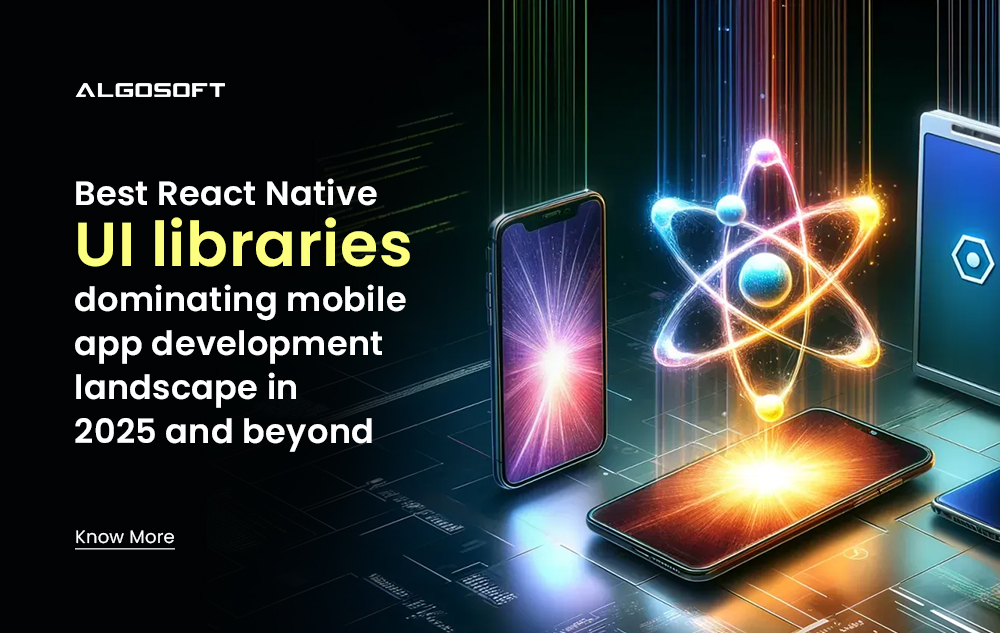Mobile App Development
Best React Native UI libraries dominating mobile app development landscape in 2025 and beyond
- Written by
Monika - Posted on
May 20, 2025

The world of mobile app development is constantly evolving, and React Native has emerged as a frontrunner in creating dynamic, cross-platform applications. With its ability to deliver stunning user interfaces while maintaining performance, many developers are turning to UI libraries that enhance their workflow and design capabilities. As we step into 2025 and beyond, understanding the best React Native UI libraries becomes essential for anyone looking to stay ahead in this competitive landscape.
These libraries not only streamline the development process but also provide a treasure trove of components tailored for various needs. Whether you’re building an e-commerce platform or a social media application, choosing the right library can make all the difference. Let’s dive into what makes these tools indispensable for modern mobile app development and discover which ones are setting trends this year and beyond.
When selecting the best UI libraries for mobile app development, several key criteria come into play. Flexibility is paramount. A library should easily adapt to different project requirements and design languages.
Performance cannot be overlooked either. Fast load times and smooth interactions are crucial for user engagement. Libraries that optimize rendering processes tend to stand out.
Another vital aspect is customization capability. Developers often need to tailor components, so a library offering extensive styling options will be more appealing.
Documentation and community support also weigh heavily in the decision-making process. Well-documented libraries with active communities provide invaluable resources for troubleshooting and inspiration.
Compatibility with existing frameworks or tools is essential as well. Ensuring seamless integration can save time and reduce headaches during development stages.
Consider the frequency of updates and maintenance from contributors; this reflects ongoing support for emerging trends in mobile app development.
React Native has gained immense popularity for mobile app development, and several UI libraries stand out in this arena.
One of the most widely used is **NativeBase**. It offers a comprehensive set of components that simplify building responsive apps. Its flexibility allows developers to customize designs effortlessly.
Another favorite is **React Native Paper**, which focuses on material design principles. This library provides a consistent look while ensuring accessibility and usability across devices.
**Galio** also deserves mention, offering beautiful components with a modern aesthetic. It’s ideal for projects requiring an elegant touch without sacrificing functionality.
Finally, **UI Kitten** captures attention with its customizable themes and clean design elements. This library embraces the power of Eva Design System, enhancing user experience significantly in mobile applications.
Each of these libraries contributes uniquely to shaping the future landscape of React Native development.
As the mobile app development landscape evolves, several emerging UI libraries are gaining traction. These libraries offer fresh approaches and innovative components that can enhance user experience.
One standout is Reanimated 2. This library focuses on smooth animations and advanced gesture handling, which are crucial for creating dynamic interfaces. Developers appreciate its performance optimizations and flexibility.
Another noteworthy contender is React Native Paper. With a comprehensive set of Material Design components, it streamlines the process of building visually appealing applications while adhering to design guidelines.
Furthermore, Native Base keeps growing in popularity by providing a wide range of customizable components that cater to both Android and iOS platforms seamlessly.
These new entrants highlight an exciting shift towards more specialized tools in mobile app development. They empower developers to create unique experiences tailored to modern users’ preferences.
Leading React Native UI libraries are distinguished by several key features that enhance the mobile app development experience.
First, customizable components offer flexibility. Developers can easily tweak styles and layouts to match branding requirements.
Next, performance optimization is crucial. The best libraries ensure smooth animations and transitions, reducing lag during interactions.
Accessibility support is another vital aspect. A library that prioritizes accessibility helps create inclusive applications for all users.
Additionally, pre-built themes save time. These ready-to-use designs allow developers to implement beautiful interfaces quickly without starting from scratch.
Responsive design capabilities guarantee that apps look great on various screen sizes. This adaptability ensures a consistent user experience across devices.
These features collectively empower developers to build high-quality mobile applications efficiently while maintaining a strong focus on user satisfaction.
Community support is vital in the React Native ecosystem. Developers benefit immensely from forums, chat groups, and social media platforms where they can share insights and solutions. The collaborative spirit fosters a vibrant community eager to help newcomers.
Documentation plays an equally crucial role. Comprehensive guides enable developers to quickly grasp library functionalities. Well-structured documentation helps streamline the learning curve for both seasoned coders and beginners alike.
Interactive examples and detailed API references enhance understanding further. Libraries with strong community backing often see frequent updates, ensuring that any issues are addressed promptly.
When evaluating UI libraries, consider how active their communities are. A supportive network can make all the difference during development phases, offering quick resolutions to common challenges faced in mobile app development projects.
When selecting a React Native UI library, integration and compatibility are crucial factors. Developers must ensure that the chosen library seamlessly fits into existing codebases. Compatibility with various platforms—iOS, Android, or web—is essential for delivering a consistent user experience.
It’s also vital to consider dependencies. Some libraries rely on specific versions of React or other tools. This can lead to conflicts if not managed carefully.
Moreover, API consistency across different devices aids in smoother integrations. Prioritizing libraries with well-defined APIs reduces development time and minimizes potential bugs.
Another aspect is the ecosystem surrounding the library. A robust ecosystem means easier access to add-ons and extensions that enhance functionality without reinventing the wheel.
Always check community feedback on integration experiences. Real-world insights from other developers provide invaluable guidance when navigating these considerations.
As mobile app development continues to evolve, so too do the UI libraries that power it. One of the most exciting trends is the rise of AI-enhanced design tools. These smart solutions can help developers create more intuitive and engaging user interfaces.
Another trend gaining traction is component-driven development. This approach allows developers to build reusable components, speeding up the design process while maintaining consistency across apps. Libraries that embrace this methodology will likely lead in usability and efficiency.
Cross-platform compatibility remains a hot topic as well. Developers are increasingly demanding frameworks that work seamlessly on both iOS and Android without sacrificing performance or aesthetics.
Accessibility is becoming a priority for many UI libraries. As awareness grows about inclusivity in tech, we can expect future libraries to prioritize features supporting diverse user needs and preferences.
The UI landscape is continually transforming, driven by advances in technology and user expectations. In recent years, we’ve seen a shift towards minimalistic designs that prioritize clarity and usability.
With the rise of mobile app development, user interfaces must be responsive across devices. This means incorporating adaptive layouts that maintain functionality without sacrificing aesthetics. As screens become more diverse, developers are challenged to create seamless experiences.
Dark mode has also gained traction, offering users the choice to reduce eye strain while enhancing battery life on OLED screens. As accessibility becomes paramount in design discussions, UI libraries are increasingly focusing on inclusivity features.
Another trend is the integration of AI-powered elements within UIs. These smart components can personalize user experiences based on behaviors and preferences—offering tailored content that keeps users engaged longer than ever before.
As these trends evolve, they will shape how developers approach their projects for years to come.
Take your business to new heights by offering unmatched mobility to your customers!


Privacy Policy I Terms & Conditions
© Algosoft Apps Technologies (P) Ltd. (CIN) U93030UP2015PTC075117
Share this article